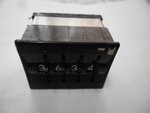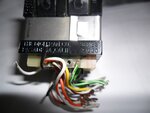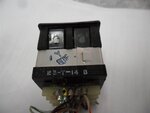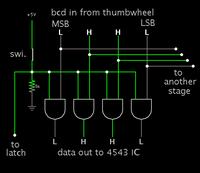skarkowtsky
Advanced Member level 4

Hi everyone-
My name is John--I'm a new forum member. A bit about me, I'm a graphic designer and amateur prop maker, though I don't know anything about electronics. Here's what I'm trying to achieve.
I'd like to use a 4 digit thumb-wheel switch (Digitran 23000) to set the numbers on a 4 digit LED display. The numbers should remain static. I don't want a clock or countdown.
Thumb-wheel:



Also, is it possible for (1) thumb-wheel switch to control (12) led readouts, independent of each other? So, each displays a different 4 digit number?
I'd appreciate any help you can offer.
Thanks!
John
- - - Updated - - -
Allow me to give a detailed explanation of what I'm hoping for. Then we can determine if it can be achieved.
Here is what I imagine:
Master power switch, connected to two 9 volt batteries wired in parallel. This supplies power to the (12) 4-digit LED displays, thumb-wheel, and whatever circuitry is required.
Each of the (12) LED displays has its own three-position ON/OFF/ON toggle switch. Wire those switches so the up position ON is now OFF, cutting power from the Master power switch. The center OFF is now ON, but not connected to the Master power switch--connected to the thumb-wheel. So, the LED display is not on, but the board is getting a signal and unique 4-digit number that I dial in on the thumb-wheel. The down position ON is connected to the Master power switch, which supplies power to the display to reveal the unique 4-digit number I assigned to that specific module.
I think this means that each of the 12 LED displays requires memory and a burn-in.
This also means that if all LED modules had their toggle switches set to the center position, I would be able to assign the same 4-digit number to all, and would be viewable if I threw all the toggles to the down position. Of course, I wouldn't do that, I want each to have a unique 4-digit number.
Does this make sense?
My name is John--I'm a new forum member. A bit about me, I'm a graphic designer and amateur prop maker, though I don't know anything about electronics. Here's what I'm trying to achieve.
I'd like to use a 4 digit thumb-wheel switch (Digitran 23000) to set the numbers on a 4 digit LED display. The numbers should remain static. I don't want a clock or countdown.
Thumb-wheel:



Also, is it possible for (1) thumb-wheel switch to control (12) led readouts, independent of each other? So, each displays a different 4 digit number?
I'd appreciate any help you can offer.
Thanks!
John
- - - Updated - - -
Allow me to give a detailed explanation of what I'm hoping for. Then we can determine if it can be achieved.
Here is what I imagine:
Master power switch, connected to two 9 volt batteries wired in parallel. This supplies power to the (12) 4-digit LED displays, thumb-wheel, and whatever circuitry is required.
Each of the (12) LED displays has its own three-position ON/OFF/ON toggle switch. Wire those switches so the up position ON is now OFF, cutting power from the Master power switch. The center OFF is now ON, but not connected to the Master power switch--connected to the thumb-wheel. So, the LED display is not on, but the board is getting a signal and unique 4-digit number that I dial in on the thumb-wheel. The down position ON is connected to the Master power switch, which supplies power to the display to reveal the unique 4-digit number I assigned to that specific module.
I think this means that each of the 12 LED displays requires memory and a burn-in.
This also means that if all LED modules had their toggle switches set to the center position, I would be able to assign the same 4-digit number to all, and would be viewable if I threw all the toggles to the down position. Of course, I wouldn't do that, I want each to have a unique 4-digit number.
Does this make sense?
Last edited by a moderator:



